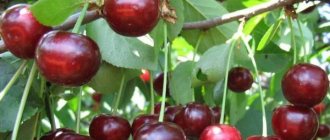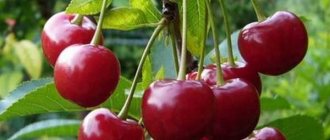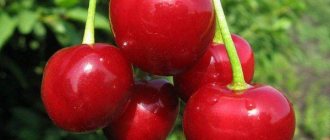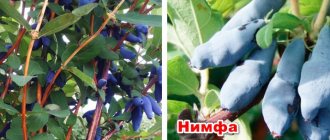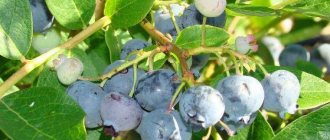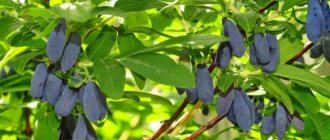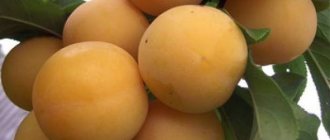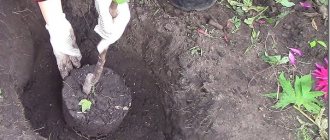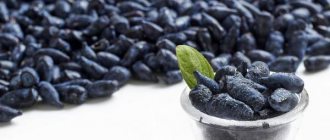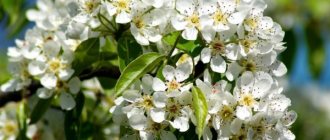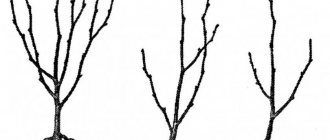Common cherry varieties
This species was known in ancient times. Today it does not grow wild.
Dessert Morozova
The variety was named after the breeder who bred it. Suitable for growing in temperate climates. Medium height plant.
The collection of branches forms a round shape. The flowers are large and white. Large-fruited – 4.7 – 5 g. The color of ripe cherries is red.
They are juicy inside. The seed is easily separated from the pulp. Can be transported over long distances. The taste is sweet, slightly sour. Productivity – up to 35 kg.
Early ripening. The first harvest is harvested in June. Fruiting occurs in the 3rd – 4th year of the plant’s life. Without a neighboring pollinating tree, only 1/5 of the fruits are formed.
It is recommended to plant the following varieties of cherries next to it:
- Vladimirskaya
- Griot Ostheim
- Studencheska
- Griot Rossoshansky
- precocity
- high yield
- pleasant taste
- annual fruiting
- frost resistance
Disadvantages include poor resistance to disease.
Youth
The variety is suitable for cultivation in the northern regions of Russia and the Moscow region. Tree height – 2 – 2.5 m. The crown is spherical, of medium density. The branches are lowered to the ground. The flowers are white. Self-pollinating.
Blooms in May. Refers to frost-resistant and drought-resistant varieties. The harvest is harvested in July. You can harvest up to 15 kg of cherries from one plant.
Fruit weight – 4 – 5 g. Cherries are dark burgundy in color. Meaty and juicy inside. Easily separated from the seed. The taste is pleasant, with sourness.
The youth variety begins to bear fruit in the 4th – 5th year of planting. The tree grows up to 15–20 years.
To plant it, you need to choose an elevated, bright area in the garden. Do not plant in places with strong drafts.
Watering is required during flowering and fruiting. Prune in the spring - before the buds swell. In the first years of life, feeding is not needed.
Youth has an average degree of resistance to mycoses.
A variety for universal use. Tolerates transportation well.
Gardeners speak well of it:
Tree up to 2.5 m high. The combination of branches forms a spherical shape. The flowers are painted white.
The first harvest can be obtained a few years after planting. Every year thereafter. Able to bear fruit without the participation of other plants.
Late ripening. Fruiting begins in July - August. Ripe cherries are dark red and juicy. Weight – 4 – 5 g.
The seed is easily separated from the pulp. They taste sour. Not prone to shedding. Used mainly for processing. Can be stored and transported.
In temperate climates, the yield is 25 kg per tree. In the south of Russia, these figures can reach up to 35 kg.
It is not suitable for planting in regions of the country with harsh climatic conditions. Susceptible to fungal diseases. Grows depending on climatic conditions for 15 - 25 years.
To grow it you need to choose a site:
- with enough sunlight
- without strong drafts
- groundwater - no higher than three meters
- exalted
Mid-season. Trees are 1.5 - 3 m high. The crown is rounded. The flowers are white, large.
The harvest is harvested in July. The trees begin to bear fruit in the 4th year of planting. They grow up to 20 years. Ripe fruits are juicy and dark red.
Weight - 4 - 7 g. The taste is reminiscent of cherries - sweet, with a slight sourness. The pulp comes off well from the seed. Suitable for fresh use and for preparations.
Productivity depends on age - 12 - 30 kg.
Not able to pollinate on its own. It is recommended to plant the following varieties of cherries next to it:
- Lyubskaya
- Apukhtinskaya
- Vladimirskaya
- Consumer goods black
- Youth
Self-fertile (self-pollinating) cherry varieties: review of the best, characteristics, photos and reviews
Among cherries, there are varieties that are classified as so-called self-fertile (self-pollinating). Among them there are trees of varying heights and frost resistance. Some prefer certain regions for growth. All this must be taken into account in order to achieve good results when growing cherries in the garden.
What are self-fertile (self-pollinating) cherry varieties?
Cherry varieties that do not require pollinators to produce ovaries are called self-fertile; in this they differ from cross-pollinated ones. Self-pollinating trees have both male and female flowers, so they set on their own.
In many self-fertile varieties, thanks to the special design of the flower, pollination can occur with an unopened bud, which allows you to get a harvest even in the absence of insects and strong wind.
Usually the number of ovaries reaches 40–50% of the total number of flowers, in partially self-fertile varieties - up to 20%.
However, in any case, the presence of pollinating varieties can significantly increase cherry yields due to the formation of additional ovaries.
Low-growing and dwarf self-fertile cherries
Low-growing and dwarf varieties are popular due to their compactness, which greatly simplifies cultivation and care. Typically, cherries of these varieties have a tree or bush height of up to 1.5–2 m.
Almost all of them, in addition to self-fertility, also have high early fruiting (fruiting occurs in the 2-3rd year after planting) and good yield.
Below are the main representatives of these varieties.
Youth
The variety has been listed in the State Register since 1993 in the Central region. Youth cherry has the following features:
- self-fertility;
- the tree is low-growing, with a rounded, drooping, medium-dense crown;
- berries weighing 4.5 g, sweet and sour;
- Flowering and ripening times are average;
- winter hardiness is high, flower buds are average;
- resistance to fungal diseases is average. Molodezhnaya cherry is considered low-growing
Tamaris
It has been listed in the State Register since 1994 for the Central Black Earth region. Its characteristics:
- this variety has very high self-pollination;
- the dwarf tree has a rounded, transparent crown and does not require formative pruning;
- berries of different sizes from 3.8 g to 4.8 g;
- blooms late, at the end of May and even at the beginning of June (depending on the region);
- tolerates frost well, but flower buds may freeze during return frosts;
- effectively resists coccomycosis, worse - other fungal diseases. Tamaris cherry fruits from 3.8 g to 4.8 g
Lyubskaya
The ancient variety was included in the State Register back in 1947 in most regions of the Middle Zone. His features:
- it grows successfully among trees only of its own variety, since it is self-pollinating, and is also considered a good pollinator for other varieties;
- cherry is a low-growing bush-type tree, the crown of which is rounded or spreading, often drooping, weeping;
- the berries are considered large, but unequal, from 4 to 5 g, while their taste is mediocre, sour;
- Cherries bloom and ripen late;
- the tree can withstand cold winters well, but when frost returns, the flower buds may suffer;
- the variety has poor disease resistance. Lyubskaya cherry blooms late
Winter-hardy self-fertile cherry varieties
A significant part of self-fertile cherry varieties have good winter hardiness.
Bulatnikovskaya
Cherry is zoned in the Central region. Characteristics:
- good self-fertility;
- compactness - a tree 2.5–3.5 m high with a semi-transparent crown;
- good harvest of small (3.8 g) sweet and sour berries in mid-July;
- flowering in the second decade of May;
- frost resistance down to -30°C, but flower buds are afraid of return frosts;
- good resistance to coccomycosis. Bulatnikovskaya cherry gives a good harvest
Rusinka
The variety is recommended for cultivation in the Central region. Peculiarities:
- good self-pollination;
- small, spreading tree;
- tasty, sweet and sour, medium-sized (3 g), but identical berries;
- late flowering;
- winter hardiness is high, flower buds are average;
- satisfactory resistance to major fungal diseases. Rusinka cherries have sweet-sour and medium-sized berries
Children's
The variety belongs to the genus of felt cherry and, like all its varieties, has high winter hardiness and drought resistance. Recommended for cultivation in all regions. Traits:
- self-fertility;
- medium-transparent, self-rooted bush 1.8 m high;
- large (3.5–4 g), bright red berries with a sweet and sour, harmonious taste;
- flowering May 17–23, ripening after 2 months;
- the bush has good frost resistance, and the flowers have good resistance to spring frosts;
- high probability of moniliosis in years with high humidity. Children's cherry is felt
Where and what self-fertile cherry varieties are best to grow?
Self-fertile cherries can be grown in all regions where cherries grow.
The best self-fertile varieties for the North-West, including the Leningrad region
For the cold climate of the Leningrad region, the most winter-hardy trees are chosen. In the State Register there are not many varieties of common cherries approved for cultivation in this region; many more of them are varieties of felt cherries. They live in all regions, and in the North-West they are common.
Cherry Lyubskaya has long settled in the North-West for a long time. The taste of the berries, of course, leaves much to be desired, but when used for processing, this drawback is easily leveled out. But Lyubka (as people affectionately call her) will never let you down and will not leave you without aromatic, vitamin-rich jam for the winter.
Amorelle Pink
Variety Amorel Pink of folk selection, in the State Register since 1947. Its yield is 6–10 kg. Other features:
- self-fertility;
- tree 2.5–3.5 m high with a dense, rounded, spreading crown;
- sweet (10% sugar), small (3 g) berries;
- early flowering and ripening;
- average winter hardiness of tree and flower buds;
- average tendency to develop coccomycosis. Pink Amorel cherry produces sweet berries
Fairy tale
Skazka is a variety of felt cherry. Suitable for all regions. Characteristics:
- self-fertility;
- self-rooted bush of medium height (1.3 m) with an oval, thickened crown;
- fruits for felt cherries are large (3.3–3.5 g) with a harmonious sweet and sour taste;
- flowering at the end of May, ripening in the second half of July;
- winter hardiness is high, for flower buds - average;
- resists coccomycosis well. The Skazka variety belongs to the felt cherries
The best self-fertile varieties for Siberia
In Siberian conditions, ordinary cherries cannot grow. Only steppe and felt cherries can withstand the harsh Siberian climate.
Self-fertile varieties of felt cherries were discussed above. Perhaps the best option for Siberia is steppe (sand) cherry, or Bessey. Coming from the North American prairies, she is called the prima donna of Siberia for her enormous advantages:
- unpretentiousness to soils and care;
- crown frost resistance up to -50 °C;
- self-fertility;
- precociousness and annual fruiting;
- good preservation of fruits: the berries do not fall off after ripening and can hang for more than a month, first filling and then withering;
- easy propagation by layering and cuttings. Bessey cherry berries do not fall from the tree for a long time
Desired
The variety has been on the State Register since 1990. Cherry yield is up to 12 kg. Characteristics:
- self-fertility;
- low-growing bush (1.6 m), raised crown, medium density;
- berries weighing 3.7 g, sweet and sour;
- Flowering and ripening dates are mid-late;
- winter hardiness is high, flower buds are average;
- resistance to coccomycosis is low. Cherry Zhelannaya produces berries weighing 3.7 g
Abundant
The variety has been listed in the State Register since 1992. Its yield is up to 12 kg. Characteristics:
- self-fertility;
- low-growing bush (1.6 m), raised crown, medium density;
- berries weighing 2.5–3 g, sweet and sour;
- late flowering and ripening times;
- winter hardiness is high, for flower buds - average;
- resistance to coccomycosis is average. Cherry Izobilnaya is characterized by late ripening
Seliverstovskaya
The cherry variety has been listed in the State Register since 2004. Characteristics:
- self-fertility;
- tree-like bush 2 m high, with a drooping crown of medium density;
- berries weighing 4.3 g, sweet and sour;
- Flowering and ripening times are average;
- winter hardiness is high, for flower buds - average;
- resistance to coccomycosis is average. Seliverstovskaya cherry bears fruit with berries weighing 4 g
The best self-fertile cherry varieties for Belarus
Belarusian breeders have developed many good, zoned varieties of cherries. Some of them are self-fertile, but, unfortunately, they are often highly susceptible to fungal diseases.
But varieties resistant to them are usually self-sterile and bear fruit only under favorable conditions. Therefore, we have to look for a “golden mean”, i.e.
choose self-fertile varieties with average resistance to diseases.
Vyanok
Vyanok is a felt cherry variety of Belarusian selection. Characteristics:
- self-fertility;
- high (2–2.5 m) pyramidal crown;
- berries weighing 4 g, taste pleasant, with sourness;
- Flowering and ripening times are average;
- winter hardiness is high, for flower buds - average;
- resistance to coccomycosis is average.
Vyanok is one of the best self-fertile cherry varieties in Belarus
Seedling No. 1
The variety was bred from ordinary sour cherries using the open pollination method. Its yield is high - 14 c/ha. Characteristics:
- partial self-fertility;
- medium-sized tree with a rounded crown;
- berries weighing 3.9 g, sweet and sour;
- terms of flowering and ripening are mid-early;
- winter hardiness is high, for flower buds - average;
- resistance to coccomycosis is good.
Cherry berries of the Seyanets No. 1 variety have a sour-sweet taste
Volochaevka
The variety is of Russian origin, but is widespread in Belarus and is considered universal. One of the most reliable varieties with a high yield of good quality fruit. Characteristics:
- self-fertility;
- medium-sized tree, spherical crown, medium density;
- berries weighing 2.7 g, with a sweet and sour taste;
- Flowering and ripening times are average;
- winter hardiness is high, for flower buds - average;
- resistance to coccomycosis is average.
Cherry Volochaevka is distinguished by a reliable and stable harvest
The best self-fertile cherries for Ukraine
For Ukraine, self-fertility is not as important as for colder regions, since growing conditions are favorable in most of the territory. They also grow a lot of cherries there, which are good pollinators for cherries. But self-fertile varieties are also present in the country.
Elegant
The variety was obtained in Ukraine. Characteristics:
- self-fertility;
- medium-sized tree, spherical crown, medium density;
- berries weighing 5 g, sweet;
- early flowering and ripening times;
- winter hardiness is average, for flower buds - below average;
- resistance to coccomycosis is high. Elegant cherry produces large berries
Lotovaya
Lotovaya is an old Western European variety. The tree grows quickly and vigorously, so it requires growth-restraining pruning. Characteristics:
- self-fertility;
- vigorous tree, dense crown, very branched, broadly pyramidal;
- berries weighing 4–4.8 g, sweet and sour;
- late flowering and ripening times;
- winter hardiness is average, for flower buds - below average;
- resistance to coccomycosis is average. Lotovaya cherry is an old Western European variety
Chocolate girl
The cherry variety has been listed in the State Register since 1996 in the Central region. Productivity is 78–96 c/ha. Characteristics:
- self-fertility;
- medium-sized tree, reverse-pyramidal crown, medium density;
- berries weighing 3 g, sweet and sour;
- Flowering and ripening times are average;
- winter hardiness is good, flower buds have average;
- resistance to coccomycosis is below average.
The ripening time of the Shokoladnitsa cherry is average
Reviews of varieties
Self-fertile cherry varieties have their advantages (no need for other varieties for pollination and less dependence on external unfavorable conditions) and disadvantages (slight resistance to diseases). However, often in cold regions the choice of such varieties is the most favorable option. The further south the area, the less important this feature is.
- Pyotr Vladimirovich Sadovnikov
Source: https://diz-cafe.com/sad-ogorod/samoplodnye-sorta-vishni.html
Cherry Memorable: description, characteristics, advantages
Cherry Memorable: description
Memorial cherry is a rather special variety. It was obtained as a result of crossing two legendary varieties - Gift to the 50th Anniversary of October and Memory of Vavilov. The result is a completely new and special variety, which is distinguished by its unique characteristics and properties. This variety has been under state testing since 2004, but has already won the hearts of a considerable number of fans from different parts of our country. This tree is of medium height, the crown is of medium density, although experienced gardeners emphasize that the planting really looks quite interesting and remarkable.
The fruits are large, round, and dark red in color. The juice is also red, very aromatic and really tasty. The fruits contain a large amount of useful substances and components, vitamins and minerals, and in general they are excellent for organizing both dietary and baby food.
Fruiting occurs approximately in the third or fourth year after the tree was planted in open ground. The advantages of the variety are that winter hardiness and general environmental sustainability are assessed at a high level, the yield is also high, and these fruits taste simply excellent. As for the downsides, experienced gardeners have so far been unable to identify any significant shortcomings. Next, we will dwell in more detail on the description of the landing and its characteristics.
The tree looks quite attractive and decorative, and you can’t help but pay attention to it. Among the advantages of the variety are the following:. - frost resistance of cherry plantings - a seedling and an adult tree can easily tolerate temperatures dropping to -25 degrees, and show absolutely no negative reactions to such changes in climate - the berries have a universal purpose - they can be used immediately after picking fresh, or they can be cooked of which are dishes, desserts, preserves and jams, compotes, drinks, juices, wines - the variety is resistant to the most common diseases and is practically not attacked by pests, insects and rodents - the variety can be propagated in different ways - by rootstocks, seeds, vegetative methods
The result will be equally positive, so you should think about this when choosing certain plantings - the variety has high commercial qualities and excellent characteristics. Cherries are great for sale, they look great, and their taste is highly rated - yields are high, even if the grower cannot give the variety enough attention and support. The berries are very appetizing, and they look simply wonderful - they have a universal table purpose, which means the gardener can use them in accordance with any of his desires and needs
- frost resistance of cherry plantings - a seedling and an adult tree can easily tolerate temperatures dropping to -25 degrees, and show absolutely no negative reactions to such changes in climate - the berries have a universal purpose - they can be used immediately after picking fresh, or they can be cooked of which are dishes, desserts, preserves and jams, compotes, drinks, juices, wines - the variety is resistant to the most common diseases and is practically not attacked by pests, insects and rodents - the variety can be propagated in different ways - by rootstocks, seeds, vegetative methods. The result will be equally positive, so you should think about this when choosing certain plantings - the variety has high commercial qualities and excellent characteristics. Cherries are great for sale, they look great, and their taste is highly rated - yields are high, even if the grower cannot give the variety enough attention and support. The berries are very appetizing, and they look simply wonderful - they have a universal table purpose, which means the gardener can use them in accordance with any of his desires and needs.
Characteristics of the variety
Putinka cherry is a productive frost-resistant variety that is resistant to diseases and pests. Knowledge of its main characteristics and growing characteristics will allow you to choose the best place for the trees and achieve high yields.
Productivity and ripening time
The first fruiting after planting occurs in the 4th year. Before this date, gardeners recommend cutting off all the flowers in the spring.
With proper agricultural technology, the variety is characterized by high productivity. From 8 to 12 tons of fruits are collected from 1 hectare of orchard.
Important! The highest yields are observed in trees grown in sunny areas.
Landing rules
The optimal time for planting cherries on the site is considered to be early spring, since if the procedure is carried out in the fall, fragile seedlings may freeze in the winter.
Important! The “Nochka” variety is represented by fairly large trees with a spreading crown, so when planting several seedlings, it is advisable to leave at least five meters of free space between them
For this reason, it is advisable to preserve even specimens purchased in the fall until spring, placing them in a cool cellar for a while or digging them into the soil. When the time comes, the young plant is taken out of storage and, after a thorough inspection (you need to make sure the viability of the seedling), proceed to planting. We recommend reading about how to properly plant cherries in the fall.
This process involves performing several sequential actions:
- 14 days before replanting, the soil in the selected area should be dug up and fertilized with organic compounds, and if the acidity is high, dolomite flour or fluff lime will have to be added to the substrate.
- A week before planting, you can dig a planting hole, the size of which in this case should be at least 60x60 cm.
- It is useful to mix the top layer of the removed soil with humus and sand, taken in equal proportions, and only then fill the bottom of the pit. The next layer will be a layer of ordinary soil (without fertilizers).
- A few hours before the planned planting of the cherry, the soil in the planting hole should be moistened so that by the time the seedling is placed, the moisture has already been absorbed.
- At the time of planting, the young plant must be held strictly vertically, with all its roots well straightened.
- From above, the root system of the seedling is covered with the remaining soil, but only so that the root collar remains above the soil level. All voids formed between the roots must be filled by simply compacting the substrate slightly.
- To complete the planting, make a shallow hole around the cherry tree and pour about 10 liters of water into it (if desired, you can mulch the tree trunk with sawdust or humus).
Video: planting cherries
Characteristics and description of trees
Cherry Iput is a fruiting stone tree with a pyramidal crown and dense dark green foliage. The height of an adult tree reaches an average of 3.5 m, some specimens reach 4.5-5 m. The bark of the tree is reddish-brown and thin.
The flowers consist of white petals touching each other. There are usually 3-4 of them in an inflorescence. The tree begins to bear fruit after the fourth year of life.
Temperature resistance
Frost resistance is one of the main advantages of this variety. Trees tolerate temperatures down to -30°C without harm. But thaws followed by sudden cold snaps are dangerous. After above-zero temperatures, frosts down to -20°C can destroy the plant.
There is no need to cover trees for the winter, but some gardeners insulate young seedlings during severe frosts by wrapping them with special covering materials, for example, spunbond.
Moisture and drought resistance
Iput is drought-resistant; water no more than once a week. Excess moisture has a bad effect primarily on the harvest - the berries begin to crack.
Resistance to diseases and pests
This variety has strong immunity to pests and diseases. However, in conditions of high humidity or after improper pruning, fungal diseases may appear (read about them below). Of the pests, aphids are the most dangerous.
The main problems when growing cherries in nurseries:
– Lack of mother plants in most nurseries and, as a consequence, frequent re-grading and a very narrow range of varieties
– Problems with rootstocks. Magalepsky Cherry or its other name, Antipka, is mainly used as a rootstock for cherries (it reproduces well, grows well and is accessible), but for heavy and waterlogged soils this is not the best option.
– Clonal rootstocks are not widely available, they are propagated in small quantities by a small number of farms, and their compatibility with various varieties has not been fully tested. He mentioned that in their nursery they use and consider the most promising clonal rootstocks VSL-2 (for cherries only), Izmailovsky, AVCh-2. I also recommended taking a closer look at B2-180, B2-158 and other rootstocks selected by the Oryol Institute (VNIISPK)
– Low yield of seedlings in nurseries due to objective problems with the survival and overwintering of oculants. All this does not contribute to the distribution of high-quality planting material for cherries.
But the main problem due to which cherries disappear from plantations is fungal diseases.
The photo shows how badly the unstable variety Vladimirskaya suffered and what the coccomycosis-resistant Griot Belorussky looks like at this time
Coccomycosis and, in recent years, Monilial burn. Infection with fungal infections occurs during flowering. There are not many cherry varieties resistant to coccomycosis, unlike sweet cherries, which are practically not affected by it (as well as moniliosis). As a result of observations of cherry plantings in the variety testing area, and in areas of different planting periods, some varieties that were relatively resistant to this fungal infection were identified. For convenience, I will present them in one list, although at the lecture they were grouped in tables according to the timing of planting.
Adaptability of cherry and sweet cherry varieties to extreme conditions of 2005/2006 and 2009/2010.
Of the fruit crops in the middle zone, stone fruit crops suffer more than others from unfavorable growing conditions. Therefore, the distribution area of the cherry culture is directly dependent on the winter hardiness of the tree and flower buds.
Currently, as a result of fruitful breeding work in a number of research institutions and, in particular, at the State Scientific Institution VNIISPK, many promising varieties of cherries have been obtained with high yield, low stature, high taste, disease resistance and other valuable properties. However, the winter hardiness of varieties requires special study.
Varieties of stone fruit crops must have sufficient winter hardiness to withstand not only typical but also severe winters. The winter hardiness of flower buds depends on a number of factors: autumn and spring frosts, severe winter frosts, returning cold after thaws and winter drying. Along with these factors, radiation and chemical load, the emergence of new diseases, and summer droughts that have become more frequent in recent years have a negative impact.
A characteristic feature of cherries is the lack of winter hardiness of flower buds, which affects the loss of yield. This is due to the fact that cherry fruit buds have a short dormant period and usually emerge from it in the second half of January; with sharp temperature fluctuations in the second half of winter, they freeze slightly [2, 3,4].
Cherry is a less adapted crop to growing conditions compared to sour cherries. It is more demanding of heat and less winter-hardy than cherry. Cherries have a longer transition to a dormant state and a sharp drop in temperature at the end of November – beginning of December leads to severe freezing of the trees [1].
Identification of resistance to the main types of winter damage was the goal of this work; a field test method was used to assess the winter hardiness of various varieties.
Methodology and objects of research
The research was carried out on experimental plots of the department of selection and variety study of stone fruit crops of the State Scientific Institution All-Russian Institute for Breeding Fruit Crops of the Russian Agricultural Academy (GNU VNIISPK of the Russian Agricultural Academy). The objects of the study were collection plantings of stone fruit crops of the State Institution VNIISPK. In total, 55 varieties of cherries and 17 varieties of black cherries were included in the study. The degree of damage to buds and tissues was assessed in the 2nd or 3rd decade of March after the growth of 1-2 year old branches after passing through dangerous frosts [5]. Freezing of wood and pith was assessed on cross sections of branches based on the intensity of tissue browning (from light to dark brown) with scores from 0 to 5.
Read also: Cherry laurel (Prunus laurocerasus)
Figure 1. – Assessment of winter hardiness of cherry and sweet cherry trees in field conditions (2006)
Figure 2 - Assessment of winter hardiness of flower buds in field conditions (2009 - 2010)
Table 1. Differentiation of varieties by groups of winter hardiness of flower buds
Shokoladnitsa, Student, Lyubskaya, Trofimovskaya, Orleya, Orlitsa, Otrada, Relay, Mtsenskaya, Josika metti, Rastorguevskaya, Igritskaya, Malinovka, Volochaevka
Putinka, Tikhonovskaya, Nepolodskaya, Excellent Kolesnikova, Livenskaya, Gift for teachers, Kizilovaya, In Memory of Mashkin, Zhukovskaya, Farewell, Businka, Shpanka, Griot Ostgeimsky, Vladimirskaya, Uifehertoy furtisch, Vyanok, Cinderella, In Memory of Sakharov
Trosnyanskaya, Zarya Vostoka
Montmorency, Orlovskaya early, Muse, Gurtievka, seedling from Kharkov, Veteranka, Zaryanka, Zhivitsa, Banquetnaya, Coeval, Novella, Excellent Venyaminova, Nochka, Turgenevka
Orlovskaya amber, Fatezh, Red dense, Donetsk giant, Orlovskaya pink, Odrinka
Brunette, Bystrinka, Petrova mole, Competitor, Renewed, Youth, Persistent, Novodvorskaya
Poetry, Adelina, Orlovskaya pink mutant, Orlovskaya fairy, Raditsa, Bryanskaya pink, Chernyshevsky seedling
Chermashnaya, Amazon, Muscat
Freezing of the vascular bundles feeding the fruit buds was carried out by examining sections made along the bud and assessed in points on the wood freezing scale.
Over the years of observation, the year 2005 had the most extreme weather conditions. 2006. In 2006, temperatures dropped to -36.5°C in February and -24.50°C in March, which led to the death of 100% of generative buds in almost all cherry varieties studied. As for freezing of trees, in the spring of 2006, after taking into account damage, the group of highly winter-hardy varieties was 12.5%, cherry - 10%, winter-hardy - 29.1%; thirty%; medium-winter hardy – 43.7%; 50%; non-winter-hardy 14.7; 10% respectively (Figure 1).
The subsequent growing season was characterized by favorable weather conditions for stone fruit crops. Late autumn and winter periods 2006/2007. characterized by a long period of low positive temperatures +1.1; +0.5; + 1.2; +2.6 (November, December, 1st and 2nd ten days of January). The third ten days of January and February were characterized by minimum temperatures from -24.5 to -27.2 ° C. These differences and the consequences of the extreme previous year left a certain imprint on the safety of fruit buds in 2006/2007. the number of varieties in which the number of dead buds was less than 25% included: cherry - Student, Shokoladnitsa, Lyubskaya, Gift for Teachers, Excellent Venyaminova, Erdi large-fruited, Anthracitovaya, Bystrinka, Zhukovskaya, Iosika meggie, Polyanka, Yubileynaya 3000, Trofimovskaya, Rastorguevskaya, Orleya, Novella, Livenskaya, Vladimirskaya, Orlitsa, In Memory of Sakharov, Griot of Ostheim, Zhivitsa, Cinderella, Zaryanka, Mtsenskaya, Relay Race, In Memory of Mashkin, Otrada, Farewell, Businka, Shpanka, Nepolodskaya, Igritskaya, Malinovka; cherries - Donetsk giant, Compact, Raditsa, Malysh, Chernyshevsky seedling, Amazon, Orlovskaya amber, Orlovskaya pink, Trosnyanskaya.
Climatic conditions of winters 2007/2008 and 2008/2009. No significant damage was caused to stone fruit plantations; damage to flower buds and freezing of trees were not observed. Weather conditions 2009/2010 with the sum of average daily air temperatures of -1024.4° C and minimum temperatures of -31.8° C in January, -21.8° C in February, -20.5° C in March, made it possible to differentiate varieties by groups of winter hardiness of flower buds (table 1).
Thus, the group of highly winter-hardy varieties in terms of preservation of flower buds was 25% for cherries; Cherry – 0%; winter-hardy - 32.1%; 11.1%; medium-winter hardy – 25%; 33.3%; weakly winter-hardy – 14.5%; 38.9%; non-winter-hardy - 3.6%; 16.6% respectively (Figure 2) Freezing of fabrics in 2005/2006. It was most pronounced in cherry varieties; damage was noted to the wood and core, as well as to the vascular bundles under the buds on annual growths.
In 2009/2010 Damage was noted in the cherry varieties Chudo-cherry and Orkolia, and in the cherries Chermashnaya, Adelina Poeziya, Raditsa, Bryanskaya rozovaya, and Malysh. Thus, as a result of field research, differences in the adaptability of cherry and sweet cherry varieties were identified, taking into account the climatic conditions of extreme winters. But the problem of winter hardiness remains completely unresolved to this day and requires further study with modeling of factors under controlled conditions according to the components of winter hardiness, taking into account the genetic potential of resistance to unfavorable overwintering conditions.
Varieties belonging to the highly winter-hardy and winter-hardy groups are recommended for industrial and amateur gardening and can be used as a valuable material in the selection of cherries for winter hardiness.
Medium-winter-hardy varieties are recommended for use in areas with milder climatic conditions.
1. Alyokhina E. M. Winter hardiness of cherry varieties // Genetic and selection problems of resistance of fruit plants to unfavorable biotic and abiotic factors: collection. report X VI Michurin readings. - Tambov, 1998. - p. 145-147.
2. Enikeev Kh. K. Results of variety study of cherries // Selection and variety study of fruit and berry crops. - M., 1966. - p. 167-207.
3. Kolesnikova A.F. Selection and some biological features of cherries in the central zone of the RSFSR. - Orel, 1975. - 328 p.
4. Kolesnikova A.F. Cherry, sweet cherry. — Kharkov: Folio; M.: AST, 2003. - 255 p.
5. Program and methodology for the study of varieties of fruit, berry and nut crops / ed. E. N. Sedova and T. P. Ogoltsova. - Orel: VNIISPK, 1999. - 608 p.
(Modern gardening No. 2, 2010)
Advantages and disadvantages
Many summer residents already know and really love the “Nochka” variety, often giving preference to it. This is not surprising, because there are many advantages of growing such cherries:
- It perfectly resists frost, making cultivation possible in the northernmost regions of the country with an unfavorable climate.
- It has excellent immunity to various ailments and pests (this greatly simplifies care, because prevention requires only a few treatments per year).
- Brings a good harvest of tasty and large berries for universal use, which also have an excellent presentation.
- It is relatively unpretentious in care and does not require frequent watering or fertilizing.
We recommend that you read the description of large-fruited, medium and early varieties of cherries.
As for the weaknesses of “Nochka”, these include the relatively low yield (only 10 kg of fruit from one tree) and the large size of the tree itself (to plant a garden, you need to have a large area).
Simply put, if you grow cherries for yourself, and not for sale, then “Nochka” certainly deserves your attention and will certainly appeal to all household members.
https://agronomu.com/bok/6027-vse-o-sortovyh-osobennostyah-vishni-putinka.html
https://sadisibiri.ru/visch-adaptiv.html
https://sampit.ru/sort-vishni-nochka-foto-i-opisanie/
Cherry-cherry hybrids
Varieties obtained by crossing cherries and sweet cherries are usually called dukes. About 30 species of such hybrids grow in Russia. Several varieties will be described below.
Kharitonovskaya
Cherry with a medium ripening period. The height of the tree is 2.5 - 3 m. The branches form a spherical shape.
The cherries are dark red in color, juicy, weighing about 5 g. Sweet and sour. The stone can be easily separated from the pulp.
But she's quite big. They have good transportability. Fruiting occurs in the 4th year of planting.
It is capable of pollinating on its own, but for good fruiting the following varieties should be planted next to it:
- it is rarely affected by fungal diseases.
- not suitable for cultivation in areas with severe frosts.
Description of the variety and photo of the Turgenevka cherry
The cherry tree has an average height (no more than 3 meters), the crown is formed according to the principle of an inverted pyramid with not very dense branches. By the fifth year of a tree’s life, the crown diameter can be 1 meter. The trunk itself and the main branches are brown with a gray tint, and the young shoots are brown.
It has been noticed that the cone-shaped buds of the Turgenevka cherry move away from the shoot. They reach 0.5 cm in length. The cherry leaf is dark green in color with a glossy tint, elongated on both sides, shaped like a boat.
As mentioned above, cherries begin to bear fruit from the fifth year after planting the tree, and with proper care they can live for 25 years. The harvest from one young tree reaches 10 kg, and an adult cherry can produce up to 25 kg of berries.
Turgenev cherry blossoms in the second ten days of May, has inflorescences of 4 flowers with white petals. Cherries begin to ripen in early July. The berries grow in clusters of four deep red cherries, shaped a bit like a heart. The petioles are 2 cm long. The large fruits (weighing up to 5 g) are sweet in taste and very slightly sour. The stone separates well, and by weight it is only 8% of the weight of the fruit (0.4 g). Thanks to this, Turgenevka gained its recognition in the field of culinary
But it is worth taking into account that if you pick cherries before they are fully ripe, they will be sour
On this topic:
BACK
FORWARD
1 of 19
Among the descriptions of the benefits of Turgenevka cherries, their good ones are highlighted:
- productivity;
- frost resistance;
- resistance to diseases.
A selection of photos of Turgenevka cherries:
Varietal features
Due to its “youth”, this line is of great interest to practical gardeners. One of the main questions is how the tree survives winter.
Winter hardiness and disease resistance
The universal variety is considered relatively winter-hardy . It is best adapted to wintering in regions with a temperate climate.
A clear advantage is resistance to diseases and pests. The branches may be threatened by fungal diseases such as moniliosis and coccomycosis (fortunately, this is rare).
Cherry is susceptible to moniliosis. The situation with pests is approximately the same - aphids, weevils or sawflies appear only in the event of a massive infection of neighboring trees.
Ripening time and yield
Mass fruiting begins in the fourth year after planting.
The wait is fully rewarded: on average, 8 tons are harvested from 1 hectare of tracts, and on good soils - even 12 tons of fruit.
Purpose
The collected berries are used for the following purposes:
- as a preparation for drying;
- for preservation (juices, jams, preserves);
- as a filling for dumplings and baked goods - casseroles and pies, pies and cakes, etc.;
- during the preparation of liqueurs, wine, tinctures and other alcoholic beverages using home technology;
- but that’s not all - dark cherries are great for making marshmallows; some people dry them in the oven or add them to meat (this gives the roast a simply gorgeous aroma).
As you can see, the fruits are truly versatile and can decorate many menu items.
We found out what makes the Putinka cherry stand out, and by what signs such trees can be recognized. We hope that our readers will take note of this data and help them make a choice in favor of this cherry variety.
Description of Putinka cherry
Cherry Putinka is a hybrid of the Anthracite and Excellent Venyaminova varieties and is considered a young variety; it was bred in 2013. As you can see from the photo of the Putinka cherry variety and from the description of the variety, the tree belongs to the category of medium-sized, grows at an average rate, the crown of the cherry is moderately dense. Putinka is a “weeping” tree with drooping branches, the shoots are covered with brownish-brown bark and have an arched shape.
The leaves of the cherry are round with a smooth taper at the tips, flat and curved down, and light green in color. The surface of the leaves is smooth and matte, covered with visible wrinkles. The tree blooms with small white and pink flowers collected in umbrella inflorescences.
Putinka is a young cherry variety, bred in 2013
Putinka cherry is included in the State Register for the Central Black Earth Region. It is recommended to grow it in a temperate climate; the tree tolerates frosts in the middle zone well, but in the northern regions it can die over the winter.
Height and dimensions of an adult tree
The maximum height of the Putinka cherry is 3 m. The crown of the tree is of medium density and drooping shape, the shoots are arched and bare. The crown usually reaches 1-1.5 m in diameter.
A characteristic feature of the tree is the weeping form of the shoots
Description of fruits
Putinka is a large-fruited variety with one-dimensional berries. In appearance, the berries are wide-rounded, covered with smooth and medium-hard skin of a dark red, almost burgundy color. The average fruit weight is 5.5 g, but some cherries can ripen up to 7 g.
Putinka's pulp is distinguished by its increased juiciness and light, unobtrusive sourness, mainly sweet cherries. The small bone is easily separated from the pulp. The tasting score of the fruit is 4.6.
Putinka fruits have a sweet, dessert taste.
Putinka is a sun-loving variety, and its fruits are rarely baked in the sun. When ripe, the berries stay on the branches for a long time, so they can be collected gradually without fear of quickly falling off.
Important! A special feature of the Putinka variety is that the berries have few subcutaneous points, and outwardly they are almost invisible
Pollinators of Putinka cherry
The flowering of the variety begins in May and lasts 7-14 days; on cloudy days, Putinka blooms longer. According to the description of the Putinka cherry variety, pollinators are not necessary for it. It belongs to partially self-fertile plants, that is, it can bear fruit without pollinators, but in this case only 5-19% of the fruits will be formed.
To obtain a bountiful harvest, it is recommended to plant pollinators near Putinka - related varieties of cherries with similar flowering periods. The varieties Zhukovskaya, Bystrinka, and Kharitonovskaya are well suited as pollinators.
It should be noted that cherries can also be used for pollination. This is practiced quite often, for example, Iput cherries are well suited for the Putinka variety.
The tree can bear fruit without pollinators, but the harvest will be small
This is interesting: Cherry Prima - we tell you in detail
Biological description
This variety is considered young - it was zoned in 2013. In fact, this is a hybrid of the Excellent Venyaminova and Anthracite lines. Such selection gave good results, as you will now see.
This cherry is distinguished by the following characteristics:
- height up to 3 m and average growth rate;
- crown of medium density. She looks drooping and “crying”;
- bare brown-brown shoots of small size. Their arched shape catches the eye;
- light green leaves with a matte tint and noticeable wrinkles. The shape is obovate, with a smooth taper at the tips;
- flat sheet plates that are bent down. "Fuzz" is missing;
- umbellate inflorescences with medium-sized white-pink flowers.
“Putinka” is large-fruited, and the berries themselves are one-dimensional. The average weight is 5.5-5.6 g, but they often ripen up to 7 g.
In appearance they are wide-rounded, and in color they are dark red (the tone is close to deep burgundy). Smooth skin of medium hardness.
The dark red flesh is very juicy. The traditional sweet and sour taste of cherries is distinguished by its subtle notes (“sourness” is felt somewhat weaker than in other varieties). A medium-diameter round stone with a smooth surface is easily separated from the pulp. Another feature of the fruit is the small number of subcutaneous points, which are almost invisible.
As for the composition, the berries contain about 10-10.5% sugars and 1% amino acids. In total with other dry substances (ash, dietary fiber and vitamins), their share reaches 17% of the total mass.
The sweetest cherry varieties for Siberia
Many summer residents do not like sour cherries, so they plant only sweet varieties of these stone fruit trees in their garden. Some of these sweetest cherries that can be grown in Siberia are listed below.
Cherry Princess
A variety of felt cherries, characterized by a sweet taste and versatility of ripe fruit.
The height of the shoots is up to 1.4-1.6 m; this variety does not have overgrowth. The princess is self-sterile, so you need to plant other varieties of cherries nearby - pollinators with the same flowering period. Cold resistance is high.
Cherry Ashinskaya
It reaches a height of 2.9-3.2 m, self-fertile, so pollinating trees need not be planted nearby. The fruits are large in size, slightly flattened, weighing up to 5.2 g. The berries have practically no sour taste, so they will appeal to those with a sweet tooth.
From one plant you can collect up to 11 kg of ripe Ashinskaya cherries.
Cherry variety Vole Michurina
A very hardy variety that does not require special care and is highly resistant to cold.
Michurina's vole is a self-sterile variety, and therefore requires planting cherry pollinating trees nearby. The taste of ripe Polevka Michurina cherries is excellent; the sweet and juicy pulp will appeal to all lovers of this berry.
Subbotinskaya bush
It is highly resistant to hot, dry periods and tolerates frost well. Ripe berries are scarlet in color with juicy sweet pulp.
Main characteristics
Before planting Putinka on your site, you need to study its main characteristics. This will allow you to understand how much care the tree requires, and whether it produces rich harvests.
Drought resistance, frost resistance
The variety tolerates short dry periods quite well. However, prolonged drying out of the soil is harmful for Putinka - it negatively affects the yield. Therefore, when growing a tree, you need to ensure that it receives enough moisture during flowering and during fruiting.
How to care
For rapid growth and development, all trees need regular care, and cherries are no exception. Representatives of the described variety require compliance with the rules of watering, fertilizing, mulching and loosening, but you should pay particular attention to the issue of pruning trees.
The hybrid of cherries and cherries is pruned in the same way as cherries, shortening the annual growth by 1/3 of its length, which is useful for the correct formation of the crown. Let's take a closer look at all the features of caring for “Nochka”.
After planting a seedling on a plot, its root system begins to grow rapidly, which is why the plant needs regular and abundant watering. In dry times, you will have to water the tree at least three times a season, pouring at least 15 liters of water under each seedling.
Adult hybrids tolerate drought well, so there is no need for additional watering. You should not over-water the trees, as stagnation of moisture will cause rotting of the root system. Overmoistening leads to the appearance of cracks in the bark of the trunk and branches, resulting in gum formation.
Basic watering should be carried out only during the flowering of trees and ripening of fruits, and 2-3 weeks before the start of harvesting, it is advisable to completely stop adding liquid to the soil.
The “Nochka” variety does not need frequent fertilizers, and if a sufficient amount of nutrients was added to the hole when planting, then the next fertilizing can be done only after five years. To prepare a nutrient mixture, it is enough to mix 0.5 buckets of mullein with two identical buckets of clean water and 0.5 kg of ash. After a week of infusion and careful straining, this nutrient mass is simply poured under the tree, at the rate of 0.5 buckets per plant. To increase productivity, just two such fertilizings, performed in early spring and during flowering, are enough, and with the arrival of autumn, you can additionally scatter a mixture of phosphorus (200 g) and potassium (80 g) fertilizers around the perimeter of the crown
Important! Nitrogen-containing compounds should be treated with special attention, since an excessive amount of this component will lead to rapid growth of the crown
Soil care
Mature cherries are quite resistant to external unfavorable factors, however, they also need periodic tillage of the soil in the tree trunk circle. Therefore, every time after watering, it is advisable to loosen the soil and remove weeds from it, and at the end of the procedure, you can mulch this area with peat, straw or slightly withered grass.
Mulching helps retain moisture and inhibits the re-development of weeds, but during rainy periods it is better to remove the layer in order to prevent stagnation of precipitation near the Nochka root system.
Hybrid forms of cherries are characterized by very rapid growth before the fruiting period, so sanitary pruning is one of the mandatory and regular measures in caring for the described variety. Find out more about the rules for spring and autumn pruning of cherry trees.
Typically, the procedure is performed in the spring and before wintering, removing all broken, dry and frozen shoots, and annual branches are cut to only 1/3 of their length. All work can be done with sharp garden shears, and it is advisable to immediately treat the cut areas with garden varnish.
Video: cherry pruning
Preparing for winter
As we noted earlier, the “Nochka” cherry is characterized by a fairly high resistance to cold, however, in case of severe frosts, it is advisable to organize a shelter (especially for young plants).
Snow mixed with sawdust will help protect the tree from the cold, which should be constantly raked under the trunk, but if there are also rodents in your garden, then you can wrap the trunk with several layers of burlap and wrap it with roofing material on top. It is advisable to protect young seedlings with metal cylinders, which are easy to find in gardening stores today. Did you know? The territory of modern Iran is considered to be the historical homeland of cherries, but it appeared on Russian soil only in the 14th century and at first was not particularly popular.
Cherry Chocolate Girl
The variety was bred at the end of the 20th century. The fruits are burgundy. This is a small tree. Its height is no more than 2.5 m. The combination of branches and leaves form a pyramidal shape.
The plant looks more like a shrub than a tree. Produces many fruits. The flowers are painted white.
Blooms in May. Cherries ripen in July. But the timing may vary in different regions. They taste sweetish, slightly sour.
The weight of one fruit is up to 3.5 g. The seed is easily separated from the pulp. Productivity – up to 15 kg. Fruiting begins 3 years after planting. Grows up to 20 years.
- cold resistance
- early ripening of cherries
- undemanding to soil moisture
- prone to infection with mycoses.
Chocolate cherry is a young variety. Therefore, its seedlings are not very easy to find on sale. To grow it, you need to choose a well-lit part of the garden.
The tree must be pruned every year. You can water during flowering and fruit formation. Feed only 3 years after planting . Then once every 4 years.
Can be grown in any region of Russia.
According to gardeners:
Features of cultivation and care
Depending on the climate and the desire of the farmer, cherries can be planted in April or October
In addition, pay attention to the following subtleties of planting and caring for the crop:
Selection of location and planting material
Before planting, select a site suitable for the variety, the optimal indicators of which are:
- illumination;
- ventilation;
- a slight elevation so that there is no stagnation of water during the rainy season;
- loamy or sandy soil;
- soil acidity is approximately 6.5 pH;
- location of groundwater no higher than 1.5 m to ground level.
Important! Avoid areas with a lot of peat, sand and clay in the composition. Chermashnaya cherry grows poorly on these types of soil and shows a low level of productivity.
Carry out preparatory work in the following sequence:
- Dig the area to a depth of 20 cm.
- When digging, add 20 kg of compost, 180 g of phosphorus and 120 g of potassium fertilizer.
- Dig a planting hole 1 m wide and 0.9 m deep.
- Mix the top layer of soil from the pit with a bucket of compost, 80 g of potash and 200 g of phosphorus fertilizer.
- Pour the resulting nutrient mixture into the planting hole and compact it.
- Prepare a solution of 450 g of lime and a bucket of water.
- Pour lime mortar into the bottom of the planting hole.
An important step when planting cherries is choosing a seedling. Planting material must meet the following criteria:
- age 1 or 2 years;
- straight trunk;
- the bark is not damaged, without rot or plaque;
- there are 3–4 branches;
- whole rhizome 30–35 cm long;
- the root system has 3–4 main roots;
- The root shoots are white when cut.
Landing
The agricultural technology of planting a seedling consists of the following stages:
- Form a small mound at the bottom of the planting hole.
- At a distance of 15 cm from the central point of the pit, drive a wooden stake up to 1.5 m high.
- Place the seedling in the hole and spread the roots over the mound.
- Fill the hole with soil so that the root collar is located 5 cm above ground level.
- Form a trunk circle with a diameter of 0.5 m.
- Water the plant with 3 buckets of water under the trunk.
- Mulch the soil with sawdust or peat.
- Tie the trunk to the stake.
Watering and fertilizing
In the first year after planting, the seedling is watered every 2 weeks. In subsequent years, the plant is irrigated four times during the growing season:
- at the moment of bud opening;
- 2 weeks after the end of flowering;
- 14–21 days before mass fruiting;
- Before the onset of frost, pre-winter moisture-charging irrigation is carried out.
5-6 buckets of water are poured under an adult tree. The amount of moisture may vary depending on the size of the tree and the weather.
There is no need to fertilize the plant for the first 2 years. The cherry tree will have enough nourishment added during planting. Then, before fruiting begins, the trees are fed twice: in May and June. Both times, urea is added to the soil in the amount of 20 g per 1 m² of soil.
After the start of fruiting, the crop is fertilized three times a year. Under one trunk add:
- at the beginning of the growing season in spring - 150 g of urea;
- in September - 100 g of potassium sulfate and 300 g of superphosphate;
- in November - 4 buckets of compost and 500 g of ash.
Pruning and crown formation
Crown formation and preventive pruning are carried out in the spring before the beginning of the growing season.
Skeletal branches are formed into three tiers according to the following principle:
- In the second year of the tree’s life, 4–5 skeletal branches of the lower tier are left. They should be at a level of 0.6–0.7 m from the ground. The optimal distance between the branches is 20 cm. The remaining branches are shortened by half the length so that the conductor trunk is 15 cm above them.
- In the third year, the skeletal branches of the lower tier are left and 2–3 skeletal branches of the second tier are identified. A distance of 0.9 m should be maintained between the tiers. Non-skeletal shoots are cut by a third of the length so that the conductive trunk is 20 cm above them.
In the fourth year, the two lower skeletal tiers are left and the upper one is formed. It should rise above the middle tier by 0.9 m. The conductor trunk is shortened so that it is no higher than 20 cm from the upper tier. In the fifth year, the conductor is cut into a ring, non-skeletal growths are cut to half the length.
The formed tree is pruned annually for sanitary thinning purposes. Old, dried, broken and frozen branches are removed from the crown.
Preparing for winter
The cherry variety Chermashnaya is cold-resistant, but the trees should be prepared for winter. At the end of autumn, gardeners:
- lime the trunks;
- they wrap the trunks with spruce branches or netting to protect them from rodents;
- cover the plants with burlap or agrofibre.
Did you know? According to archaeologists, cherries were grown in the 7th century BC. e. inhabitants of pile buildings in the territory of modern Denmark and Switzerland.
Landing Features
The Lyubskaya variety has very high self-fertility. Still, to maximize the yield, it is better to plant cherries such as Zhukovskaya, Lotovaya, Anadolskaya, Vladimirskaya nearby. As a rule, Lyubskaya itself is a good pollinator for other varieties of cherries.
Selecting a location
Lyubskaya cherry is quite demanding on soil and growing conditions. The best for it are loose, fertile soils with a neutral reaction. Loamy and sandy loam soils are well suited, provided they are well supplied with organic fertilizers and minerals. The landing site should be protected from cold winds and well lit by the sun. As a last resort, partial shading is allowed. A distance of 2–3 m must be maintained from buildings and neighboring trees.
To reduce the pressure of the wind, you can simply pull the mesh
Groundwater should be no closer than 1.5 m from the soil surface. If they are located closer together, drainage or planting of cherries on an artificial hill is necessary.
The variety is considered unsuitable for cultivation in the northern regions, but many gardeners believe that cultivation in stylite forms is possible.
Selection of planting material
One-year-old seedlings are considered the best planting material, but two-year-old seedlings can also be purchased. The purchased trees must have a well-developed crown and roots. All organs of the tree must be intact, without dry or damaged areas.
Pay special attention to inspecting the root collar (there should be no influx of tissue at the grafting site, cracks, or rot)
When choosing a seedling, pay attention to the degree of development of the crown and roots
Landing dates
The recommended time for planting cherries is spring (April). But in the southern regions you can plant in the fall, at the beginning of October.
It is important to plant the tree so that it has time to take root before the onset of frost (this takes about 1 month). Spring planting should be done when the soil has already completely thawed, but be sure to do it before the buds open.
Preparing for landing
Successful rooting of a seedling largely depends on proper soil preparation. The primary requirement is to remove weeds from the intended area and loosen the soil. If it is necessary to cultivate the soil, fertilizers should be applied (15–18 kg/m2 of organic matter and 200 g of a mixture of phosphorus and potassium compounds). To reduce acidity, you will need 300–600 g/m2 of crushed dolomite or chalk.
The pit for planting should be ready 15–20 days before planting; the best option is to prepare the pits in the fall. The dimensions must correspond to the parameters of the root system. For a cherry tree, the minimum dimensions are 0.5–0.6 m in depth and 0.8–1 m in diameter. Make the walls even, loosen the bottom with a fork and drive a 1.4 m long peg into the center. Fill 1/3 of the depth of the hole with a nutrient mixture (fertile soil, 2–2.5 buckets of organic fertilizers, 0.5 kg of ash and 200 g of superphosphate) .
Landing
Check the condition of the tree again, remove dry and broken roots with a sharp knife. If the roots become very dry, immerse the seedling in water for 18–24 hours.
Step-by-step landing sequence:
- Dip the roots of the tree in soil mash.
- Place the seedling in the hole, carefully straightening the roots.
- Sprinkle the roots with soil gradually, in layers, trying to fill all the spaces between the roots. Compact each layer with your hands. You can add water so that the soil adheres more closely to the roots.
- After filling the hole, press down the soil with your foot.
- Create a watering hole.
- Tie the tree to the support stake with a soft rope. Carry out the first watering with 2-3 buckets of water.
